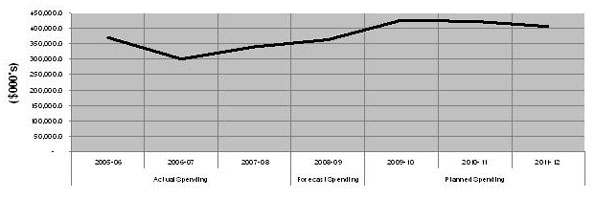Common menu bar links
Breadcrumb Trail
ARCHIVED - Public Safety and Emergency Preparedness Canada
 This page has been archived.
This page has been archived.
Archived Content
Information identified as archived on the Web is for reference, research or recordkeeping purposes. It has not been altered or updated after the date of archiving. Web pages that are archived on the Web are not subject to the Government of Canada Web Standards. As per the Communications Policy of the Government of Canada, you can request alternate formats on the "Contact Us" page.
Minister’s Message

The Department delivers programs and develops policy on a wide range of public safety issues, including national security, emergency management, law enforcement, corrections, crime prevention, and border management. In striving to ensure the safety and security of Canadians, the Department supports the quality of life of all Canadians and directly contributes to the most fundamental responsibility of Government which is to protect our citizens.
In the past year, the Department was able to obtain government-wide support for the Federal Emergency Response Plan; implemented the Police Officers Recruitment Fund; renewed the National Crime Prevention Strategy; worked towards the renewal of the National Strategy for the Protection of Children from Sexual Exploitation on the Internet; helped build increased capacity in
Aboriginal communities across Canada to address crime and victimization; and prepared a new “GetPrepared.ca” website for launch in 2009.
This Report on Plans and Priorities lays out the full scope of the Department’s plans and key activities to be pursued during the 2009-10 fiscal year. Public Safety Canada will continue to pursue specific priorities in the areas of national security; emergency management; policing and law enforcement; crime and safety; and border management. The Department will also focus on supporting Canada’s development and reconstruction efforts in Afghanistan, and will work in collaboration with its national and international partners to help ensure the safety and security of the 2010 Olympic and Paralympic Games.
It is this continued development of policy and delivery of programs that supports the Department’s pursuit of a safe and resilient Canada. I remain confident that Public Safety Canada will continue to enhance the safety and resiliency of Canadians in the years to come. I would also like to emphasize how important it is, and has been, for the Department to work with its Portfolio agencies, other federal departments and agencies, Provinces and Territories, municipalities and our partners in the public and private sectors to meet its objectives.
The Honourable Peter Van Loan, P.C., M.P.
Minister of Public Safety
Section 1: Departmental Overview
Public Safety Portfolio
The Public Safety Portfolio is large and complex. It encompasses nine distinct organizations all of which directly contribute to the safety and security of Canadians. In addition to Public Safety Canada, the Portfolio includes the Canada Border Services Agency (CBSA), the Canadian Security Intelligence Service(CSIS), the Correctional Service of Canada (CSC), the National Parole Board (NPB), and the Royal Canadian Mounted Police (RCMP). It also includes three arms-length review bodies: the RCMP External Review Committee, the Commission for Public Complaints Against the RCMP, and the Office of the Correctional Investigator.
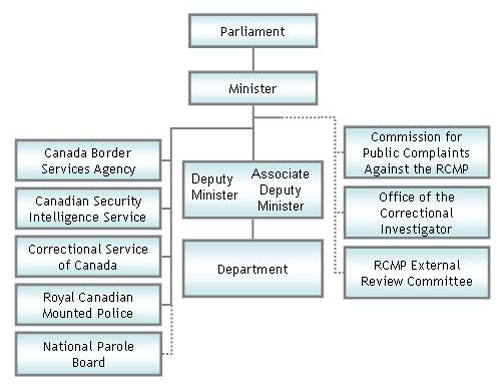
Public Safety Canada’s Responsibilities
Public Safety Canada plays a key role in developing policies, delivering programs and ensuring cohesion and integration on policy and program issues within the Portfolio. The Department works with other federal departments, other levels of government, first responders, community groups, the private sector and other countries to achieve its objectives. Through the development and implementation of clearly articulated policies and programs, the Department works towards the achievement of its strategic outcome: “A safe and resilient Canada”.
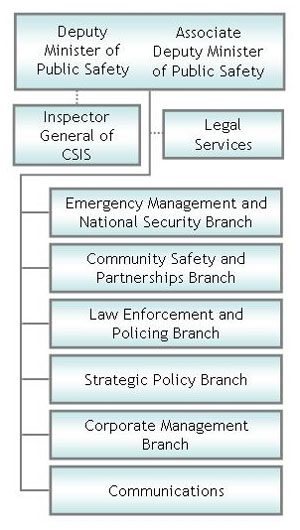
To keep Canadians safe from a range of threats, the Department provides strategic policy advice and support to the Minister of Public Safety on a range of issues, including: national security; emergency management; policing and law enforcement; border management; corrections; Aboriginal policing; and, crime prevention.
The Department also delivers a number of grant and contribution programs to Canadians related to emergency preparedness and response, and community safety. Almost 65 percent of the Department’s budget is devoted to grants and contributions funding.
Public Safety Canada is structurally organised into five branches: Emergency Management and National Security, Community Safety and Partnerships, Law Enforcement and Policing, Strategic Policy and Corporate Management. The Branches are supported by the Communications Directorate and the Legal Services Unit. Also situated within the Department is the Office of the Inspector General of CSIS, which carries out independent reviews of CSIS’ compliance with the law, ministerial direction and operational policy.
Strategic Outcome and Program Activity Architecture
The chart below illustrates Public Safety Canada’s strategic outcome and framework of program activities.
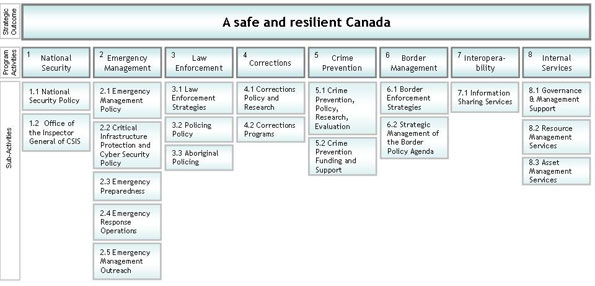
In 2008-09, Public Safety Canada updated its Program Activity Architecture (PAA) to reflect all sub-sub activities. The updated PAA and ongoing development of the Department’s Performance Measurement Framework (PMF) will inform decisions on program relevance, effectiveness and value for money; support the realignment of spending and the identification of horizontal linkages among programs; and provide better information to parliamentarians and Canadians on spending and results.
The performance measures and indicators currently found within this document stem from the Department’s draft PMF. As the Department has recently completed the initial draft of this framework, 2009-10 will be the first year it will be tested to gauge performance. A number of performance indicators specified within this report lack specific targets due to the absence of baseline data at the time of publishing. Once baseline data is collected and consolidated, the Department will develop related standards and targets. The development and refinement of the PMF remains a priority; the Department will continue to work closely with its Portfolio counterparts to ensure that there is a degree of coherence amongst the performance measurement frameworks of each of the portfolio agencies with that of the Department in an effort to demonstrate results to Canadians from a portfolio-wide perspective and to strengthen its management of public funds.
Further information on the Department’s Program Activity Architecture (PAA) is available at http://www.publicsafety.gc.ca.
Planning Summary
|
Financial Resources ($000’s) |
|
Human Resources (Full-Time Equivalents) |
||||
|---|---|---|---|---|---|---|
|
2009-10 |
2010-11 |
2011-12 |
|
2009-10 |
2010-11 |
2011-12 |
|
425,973.9 |
421,957.5 |
407,325.2 |
|
1092 |
1084 |
1060 |
|
Strategic Outcome |
A safe and resilient Canada. |
||||
|
($000’s) |
|||||
|---|---|---|---|---|---|
|
Forecast Spending |
Planned spending |
||||
|
2008-09 |
2009-10 |
2010-11 |
2011-12 |
||
|
National Security |
5,883.1 |
7,025.5 |
6,784.5 |
6,984.5 |
A safe and secure Canada |
|
A safe and secure world through international cooperation |
|||||
|
Emergency Management |
134,828.8 |
169,603.4 |
166,223.2 |
159,857.7 |
A safe and secure Canada |
|
A safe and secure world through international cooperation |
|||||
|
Law Enforcement |
101,854.1 |
126,412.0 |
126,749.0 |
126,697.3 |
A safe and secure Canada |
|
Corrections |
7,636.2 |
7,411.4 |
7,040.6 |
7,040.6 |
A safe and secure Canada |
|
Crime Prevention |
33,993.8 |
64,434.7 |
64,434.4 |
57,238.6 |
A safe and secure Canada |
|
Border Management |
1,791.1 |
2,093.4 |
2,103.4 |
2,014.1 |
A safe and secure Canada |
|
A safe and secure world through international cooperation |
|||||
|
A strong and mutually beneficial North American Partnership |
|||||
|
Interopera-bility |
10,289.6 |
3,456.9 |
3,456.9 |
3,456.9 |
A safe and secure Canada |
|
Internal Services |
66,394.9 |
45,536.7 |
45,165.6 |
44,035.5 |
A safe and secure Canada |
|
A safe and secure world through international cooperation |
|||||
|
A safe and secure Canada |
|||||
|
Total |
362,671.5 |
425,973.9 |
421,957.5 |
407,325.2 |
|
|
Services received without charge |
15,994.3 |
17,205.4 |
17,311.5 |
17,216.7 |
|
|
Total Cost |
378,665.8 |
443,179.4 |
439,269.0 |
424,541.9 |
|
The figures have been rounded to the nearest thousands of dollars. Due to rounding, figures may not add up to the totals shown.
Note: Planned Spending reflects funds requested through the Main Estimates plus adjustments for funding approved in the Government fiscal framework.
Priorities Summary
In pursuit of the Department’s Strategic Outcome of a safe and resilient Canada, Public Safety Canada will direct its efforts towards five policy/operational priorities and two management priorities in 2009-10. The implementation of these priorities will allow the Department to continue to support Government-wide commitments to the establishment of a safe and secure Canada, a safe and secure world through international cooperation, as well as a strong and mutually beneficial North American partnership.
|
|
Key Priorities |
Type |
PAA Link |
Description |
|---|---|---|---|---|
|
1 |
Develop a whole-of-government approach to Cyber Security |
New |
Emergency Management/ National Security |
Collaborate with other departments and agencies and international and domestic partners to lead the development of a whole-of-government Cyber Security Strategy to achieve cyber integrity of government, protect the economy and critical infrastructure, combat cyber facilitated crime, protect citizen safety and enhance national security. |
|
2 |
Establish networks to share information and manage risks in each of the ten critical infrastructure sectors |
New |
Emergency Management |
Work with other federal sector lead departments to establish sector networks to share information and manage risks in each of the ten critical infrastructure (CI) sectors. Critical infrastructure refers to processes, systems, facilities, technologies, networks, assets and services essential to the health, safety, security or economic well-being of Canadians and the effective functioning of government. |
|
3 |
In collaboration with the RCMP, TBS and others, develop proposals for government consideration to strengthen RCMP governance and accountability, including modernizing the RCMP review and complaints body |
New |
Law Enforcement |
Develop proposals, including those related to the introduction of legislative amendments, to modernize the RCMP review and complaints body and strengthen governance and accountability. |
|
4 |
By 2012, negotiate and renew police service agreements with eight provinces, three territories and 180 municipalities for the provision of policing by the RCMP |
New |
Law Enforcement |
Progress towards the development of a framework agreement, a common fact base, and principles to guide negotiations towards the renewal of police service agreements. |
|
5 |
Develop options to strengthen legislation related to community safety, such as the Sex Offender Information Registration Act and the Corrections and Conditional Release Act |
New |
Corrections |
Develop proposals, including the possible introduction of legislative amendments geared towards improving the effectiveness of the National Sex Offender Registry and the Corrections and Conditional Release Act to enhance public safety. |
Public Safety Canada will also support whole-of-Government efforts with the following priorities:
| Shared Priority |
Type |
PAA Link |
|---|---|---|
|
Support Canada’s development and reconstruction efforts in Afghanistan |
New |
National Security |
|
Support partners in safety and security matters related to the 2010 Olympic Winter Games |
New |
Law Enforcement/Emergency Management/ |
|
|
Management Priorities |
Type |
PAA Link |
Description |
|---|---|---|---|---|
|
1 |
Improve Management Accountability Framework assessment results related to Internal Audit, Evaluation, Management of Security and Business Continuity and Quality Reporting to Parliament |
New |
Internal Services |
Continued implementation of the Quality Assurance and Improvement Plan and a Departmental Audit Committee; establishment of a corporate evaluation function; continue to improve the resiliency and security of Information Management/Information Technology infrastructure; and continued advancement of the implementation of the Management, Resources and Results Structure Policy. |
|
2 |
Address the Public Service Employee Survey results and develop an action plan |
New |
Internal Services |
The Department will determine the necessary initiatives, such as programs, policies, tools, etc., required to respond to any potential workplace challenges raised by employees. |
In addition to the above-mentioned priorities, Public Safety Canada will also continue to deliver on the following key priorities identified in 2008-09:
| Ongoing Priorities |
PAA Link |
|---|---|
|
Strengthen Canada’s national security framework |
National Security |
|
Implement evidenced-based interventions in communities to prevent youth from joining gangs and support their exiting from gangs |
Crime Prevention |
|
Develop a Canadian strategy for enhanced border management, including the development of new and effective border and cross-border law enforcement initiatives |
Border Management |
Risk Analysis
Public Safety Canada is influenced by internal and external factors. The Department works with more than 30 departments and agencies, Provinces and Territories, international partners, the private sector and first responders in its efforts to keep Canadians safe from evolving threats. As such, the effectiveness of these relationships impacts the work of the entire Department and remains key to the successful advancement of the Department’s policy and program agenda.
Internally, the Department continues to improve its management tools through, the development of a more coherent approach to performance management. The completion of a Program Activity Architecture, the first draft of a Performance Measurement Framework and the formalization of a department-wide business planning process represent several of the Department’s achievements. Public Safety Canada will be working on the finalization of a risk management framework and the establishment of a corporate evaluation function in an effort to build on these successes to support improved decision-making.
Externally, the safety of Canadians is threatened by a variety of risks. Given its wide range of responsibilities, Public Safety Canada must take into consideration risks ranging from those associated with natural disasters to threats to Canada’s national security. By ensuring that significant risks are identified and assessed, and by ensuring proper coordination with our Portfolio Agencies in terms of how to adequately address threats to our safety and security, the Department continues to support a safe and resilient Canada.
Expenditure Profile
|
($000’s) |
Forecast Spending |
Planned Spending |
||||
|---|---|---|---|---|---|---|
|
Actual Spending |
||||||
|
2005-06 |
2006-07 |
2007-08 |
2008-09 |
2009-10 |
2010-11 |
2011-12 |
|
369,722.0 |
300,453.0 |
339,905.9 |
362,671.5 |
425,973.9 |
421,957.5 |
407,325.2 |
|
|
||||||
Changes between planned spending in the 2008-09 RPP and 2009-10 are mainly due to:
Increases:
- Renewal of the temporary funding for the National Crime Prevention Strategy to support community-based programming to reduce offending among at-risk and vulnerable populations ($29.2M).
- Funding received from RCMP for policy development in the areas of front-line policing and national policing ($1.5M).
- Funding provided to cover salary increases of the Regular members of the RCMP engaged in the First Nations Policing Program ($1.0M).
Decreases:
- Decrease in funding related to a reduction in the anticipated payments to provinces and territories for assistance related to natural disaster under the Disaster Financial Assistance Arrangements ($30.0M).
- Sunsetting of the funding for the Campaign: "72 Hours - Is your family prepared?" ($3.0M).
- Sunsetting of funding made available for National Integrated Interagency funding ($2.9M).
- Sunsetting of the funding for Cyber Security Task force ($1.4M).
Planned spending over the period from 2009-10 to 2011-12 diminishes by $18.6M or 4% mainly because of reductions related to the sunsetting of funding for:
- The Action Plan to enhance Passenger, Rail, Mass Transit and Ferry Security ($2.8M);
- Temporary funding provided to augment emergency management capacity ($9.1M);
- Sunsetting of special programming under the National Crime Prevention Strategy that was targeted to the Prevention of Youth Gangs ($7.3M).
This figure displays the allocation of Public Safety Canada’s planned spending by program activity for 2009-10 (in $000’s).
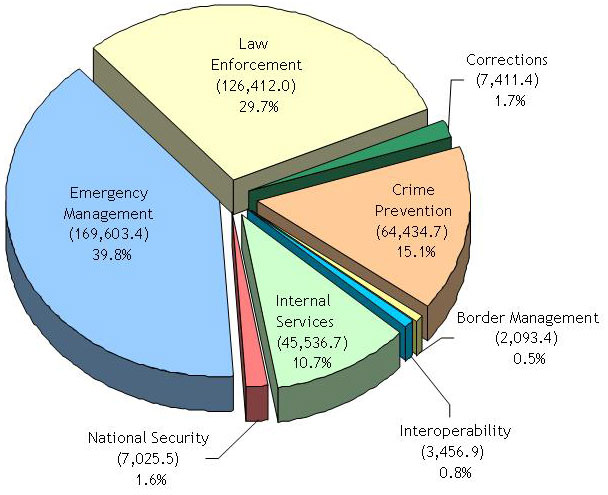
|
Vote # or Statutory Item (S) |
Truncated Vote or |
2008-9 |
2009-10 |
|---|---|---|---|
|
Main Estimates ($000’s) |
|||
|
1 |
Operating expenditures |
121,588 |
137,410 |
|
5 |
Grants and Contributions |
281,315 |
271,363 |
|
(S) |
Contributions to employee benefit plans |
12,003 |
13,235 |
|
(S) |
Minister of Public Safety salary and motor car allowance |
76 |
78 |
|
|
Total |
414,982 |
422,086 |

